Heavy tank Fiat 2000 (Italy)
It should be noted that the French-made vehicles could become the first tanks of the Italian army. Seeing difficulties in developing their own projects, Rome decided to seek help from the allies. In 1917, negotiations began on the acquisition of French machines of the Schneider CA1 and Renault FT-17 types. Nevertheless, the French army itself needed such a technique, because of which the customer could only get a few machines of two types. For this reason, for some time Italy had to rely only on its own strength. The lack of alternatives led Italian specialists to speed up the work, so that at the beginning of the next 1918, a prototype of the first domestic tank of its own design was put to the test.
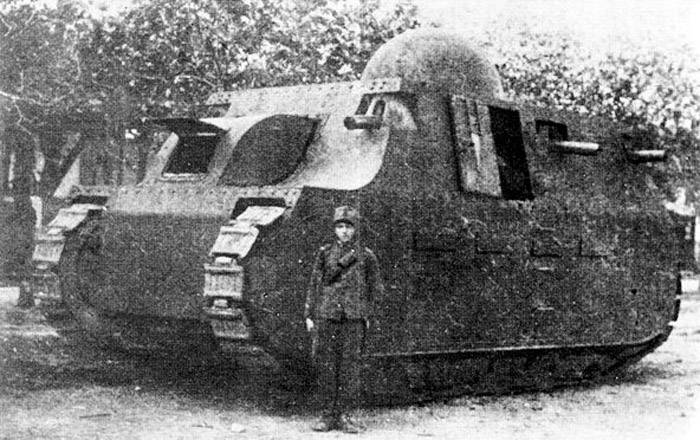
Serial tank Fiat 2000. Photo Armor.kiev.ua
In 1916, several organizations received an order to create tanks with different parameters, including Fiat. According to some reports, the development of a new project began even before receiving an official order. The Fiat specialists familiarized themselves with the latest developments of foreign countries, after which they offered their version of a similar purpose machine. The first Italian design of the tank was designated Fiat 2000.
In the initiative project, it was decided to apply a non-standard approach, which allowed to survive the potential failure of a potential customer without any problems. At first, it was necessary to create a new tracked chassis with the engine of the required power and the corresponding transmission. Then at its base it was necessary to develop a tank. Upon receipt of the official order could continue to work. Otherwise, the chassis was planned to be finalized and made the basis for a promising tractor of a heavy class. In this regard, in particular, the chassis with the layout of the tank corps was the first to be tested under the program. It was only after completing the checks on the undercarriage and powerplant that Fiat engineers were able to do a full-scale design of other units.
Having studied the known cases of the use of tanks and the experience gained in their operation, the authors of the Fiat 2000 project formed a general concept in accordance with which the new tank was to be built. Prospective combat vehicle was considered as a mobile firing point. It had to move over rough terrain, including those covered with explosive craters, accompany the infantry at an appropriate speed, and hit the enemy with cannon and machine-gun fire without significant difficulties. Such combat use meant the same level of protection against shelling from any angle, and also required the use of a large amount of weapons capable of providing intensive simultaneous shelling of several targets in different directions.
At that time, there were no proven and generally accepted versions of the overall tank architecture, which is why original ideas were used in the Fiat 2000 project, as in many other developments of the time. Based on the existing requirements for protection and armament, the authors of the project formed an unusual, by modern standards, machine design. In particular, the characteristic features of the Italian tank were the placement of power units, as well as the approach to installing weapons.
The body was proposed to be assembled on a frame of armor plates of different thickness. The sides and screens of the undercarriage should be made of 20-mm armor. Sheets 15 mm thick were offered for the roof and the bottom. The design of the tank used both straight and curved panels. The frontal part of the body had a relatively complex shape. A vertical frontal sheet was placed at the bottom, above which a small height component was fastened under an inclination. Above it, in the central part of the forehead, was the driver’s cabin, consisting of a curved forehead-roof and two vertical sides. On the sides and on top of the cabin there was a U-shaped concave leaf inside. In the onboard parts of it were provided small openings for installation weapons.
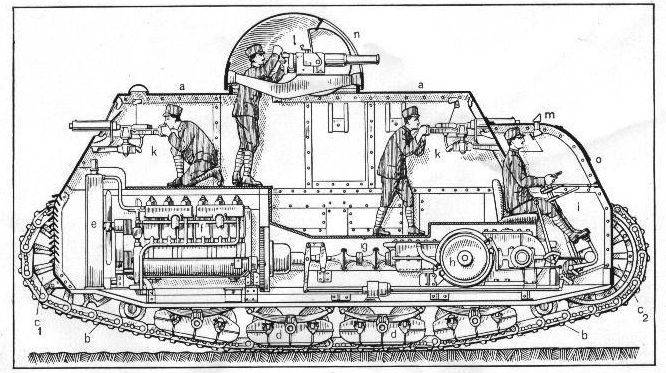
The layout of the tank, depicts the crew members. Figure Tanks-encyclopedia.com
The lower part of the body had the same width as the lower frontal leaf. On these details were provided for mounting elements of the chassis. Above the lower part, the hull increased its width, forming rather large felled niches. Sideways, these niches were covered with inclined side sheets. Below sloping sides were vertical side screens protecting the running gear. In the stern there was a wide sloping top sheet and a vertical bottom one, distinguished by a smaller width. In the latter there were blinds for air supply to the radiator. Above the hull was covered with a horizontal roof.
The first prototype of the Fiat 2000 tank received a turret made in the shape of a six-sided truncated pyramid. Subsequently, such a design was abandoned in favor of a hemispherical unit. Regardless of the form, towers of two types were assembled from sheets of the required shapes and sizes on the basis of the frame.
An interesting feature of the first Italian heavy tank was the layout of the internal volumes of a relatively large and high armored hull. The lower part of the body was given under the engine compartment, placed under the floor of the habitable compartment. In the stern of the tank, under the casing of appropriate sizes, was located the engine. Clutch, gearbox and other units were held under the floor of the fighting compartment and connected to transmission devices located in front of the car. There was a transfer of torque to the drive wheels. This arrangement of the engine compartment allowed the tank to be equipped with all the necessary units, as well as to a certain extent simplify the design of the controls: the levers and pedals were located at a minimum distance from the devices they controlled.
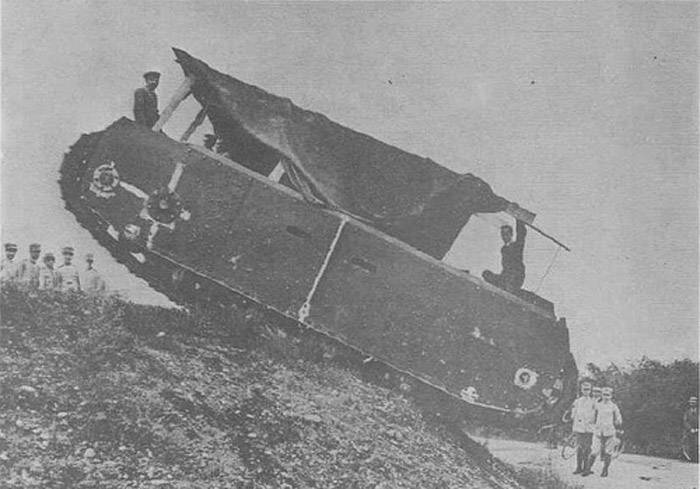
Prototype with a lightweight body. Photo Aviarmor.net
In the rear of the tank was installed aviation 12 hp Fiat A240 carburetor engine The engine had a liquid cooling system with a radiator placed opposite the aft grill of the hull. A mechanical transmission was connected to the engine, providing six forward speeds and two reverse speeds. Due to some features of the body layout, the authors of the project were not able to use the direct transmission link with the drive wheels. Because of this, the latter were set in motion by a chain drive located outside the housing, but under the protection of the side screens. The output shafts of the transmission were approximately at the level of the front track rollers.
Tank Fiat 2000 received chassis based on dual track rollers mounted on trucks. On each side of the car was installed eight road wheels on four carts. Semi-elliptical springs were used in the suspension. The suspension was distinguished by the low speed of the rollers, which affected the softness of the movement, not allowing to “work out” all the irregularities. In the stern of the tank were located the guide wheels, in the front - leading. The driving and guiding wheels were distinguished by their large diameter and spoke-shaped design. To improve cross-country ability, they were raised above the supporting surface. The teeth for the chain transmission were provided on the drive wheel hub. Between the end carriages and the driving / steering wheels, two pairs of additional rollers were provided, reducing the load on the tracks when overcoming obstacles. A metal gutter was used to maintain the upper branch of the caterpillar.
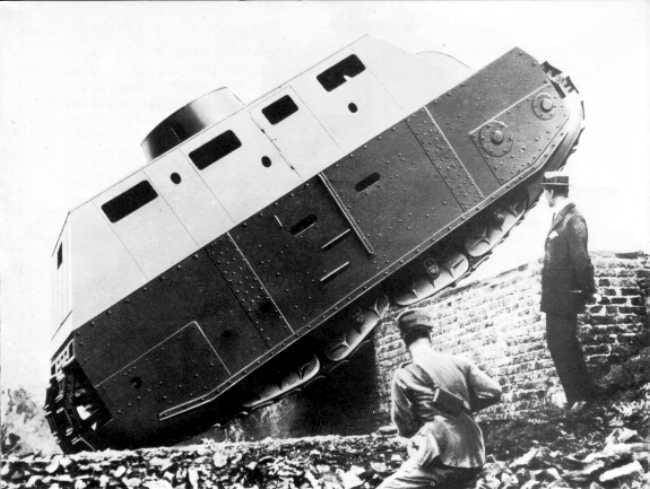
The prototype with the body of the first version. Photo Aviarmor.net
The design of the caterpillar was typical for the technique of the time. Coarse tracks, 450 mm wide, whose tracks had a pronounced cushion with a lug grip, were used. On the inside of the track there were rails for track rollers. Due to the removal of the leading and guiding wheels, the front and rear parts of the tracks significantly protruded beyond the hull and side screens, further improving throughput.
The most powerful weapon of the Fiat 2000 tank was the Cannone da 65 / 17 modello modello 13 mm caliber 65 mm, adopted for use in the 1913 year. With the help of this weapon, having a barrel length 17 caliber, it was possible to attack targets at distances up to 6,8 km. The gun together with the swinging part of the original carriage was proposed to be mounted on the axles of the tank tower. The design of the tower provided for a large embrasure, covered with a movable armor shield-mask. Shooting was provided in any direction with different elevation angles.
Also, the tank received a developed machine gun armament. In the corners of the hull, as well as in the central part of both sides and in the stern sheet, above the engine, were placed seven machine-gun installations. Swivels with movable flaps of complex shape allowed for targeting machine guns within wide horizontal sectors, up to 100 °. Also, the design of weapons installation made it possible to search for targets and direct machine guns with minimal risk of hitting enemy fire. On all seven installations, 6,5-mm machine guns Fiat-Revelli M1914 were mounted. These machine guns, using 50 magazine ammunition, showed a rate of 400 rounds per minute. The weapon was completed with bags-sleeve.
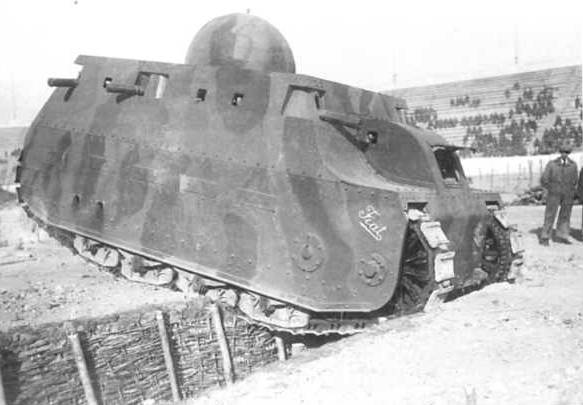
Serial Tank Demonstrates Permeability, Rome, 2 April 1919. Photo by Aviarmor.net
Control of the tank was entrusted to the crew of 10 people. In front of the hull, under the wheelhouse, in his own seat was a driver-mechanic, who also served as a commander. The work of the turret gun was controlled by the gunner and loader. Each machine gun is serviced by its own shooter. It should be noted that due to the small size of the reserved volume, crew jobs were not very convenient. Moreover, comparative convenience was provided only for the driver-commander. The least comfortable crew workplace on a Fiat 2000 tank is considered to be aft machine gun installation. While other machine gunners had the opportunity to work standing up and straightening, the stern shooter was forced to kneel, which worsened the convenience and efficiency of work.
The driver-commander outside the combat situation had to watch the road with a large hatch in his wheelhouse, the hatch of this hatch was folded up. In order to avoid enemy fire damage, in a battle the commander had to close the hatch and use a periscope viewing device. Interestingly, this was the first successful case of equipping a tank with a periscope in world practice. Other crew members were to monitor the situation with inspection hatches and slots, as well as using the sights of their weapons. With some problems, there was an almost all-round view with the possibility of firing targets in any direction, including several machine guns at the same time. It was proposed to get into the tank with the help of a common door on the port side.
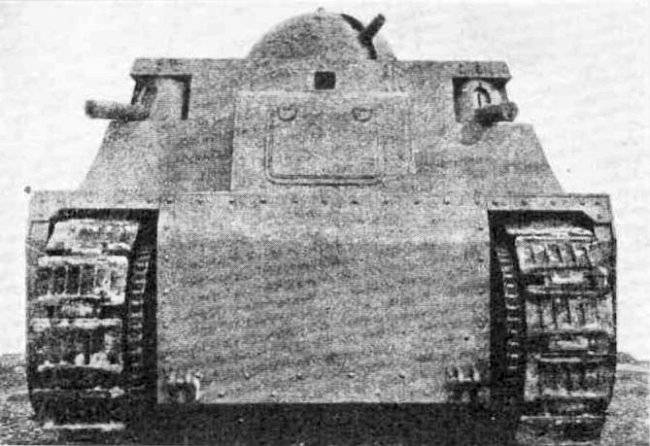
Frontal part of the car. Photo Daywarphoto.blogspot.ru
The first Italian tank turned out quite large and heavy. The length of the machine reached 7,4 m, width - 3,1 m, height - 3,4 m. Ground clearance was equal to 540 mm. The combat weight reached 42 T. The negative specific feature of the machine was to be a low power density, which could worsen the mobility indices, around 5,7 HP. per ton.
According to reports, back in 1917, Fiat built an experienced tank chassis, whose main task was to demonstrate the capabilities of a promising vehicle. Chassis, power plant and transmission of the prototype is fully consistent with the developed project. At the same time, a simplified design body was used, which had no upper part and was built from structural steel. In this form, the prototype was tested, according to the results of which some changes were made to the existing structure. In addition, the completion of testing an experienced chassis allowed to continue work on the creation of a full-fledged tank.
In February, 1918, the Fiat company, built and presented for testing the first full-scale prototype of a heavy tank. He carried a faceted tower. In addition, a characteristic feature of the first prototype was a two-tone camouflage paint, similar to that used by the French army. In this form, the armored vehicle entered the field tests, during which it showed the main characteristics and capabilities.
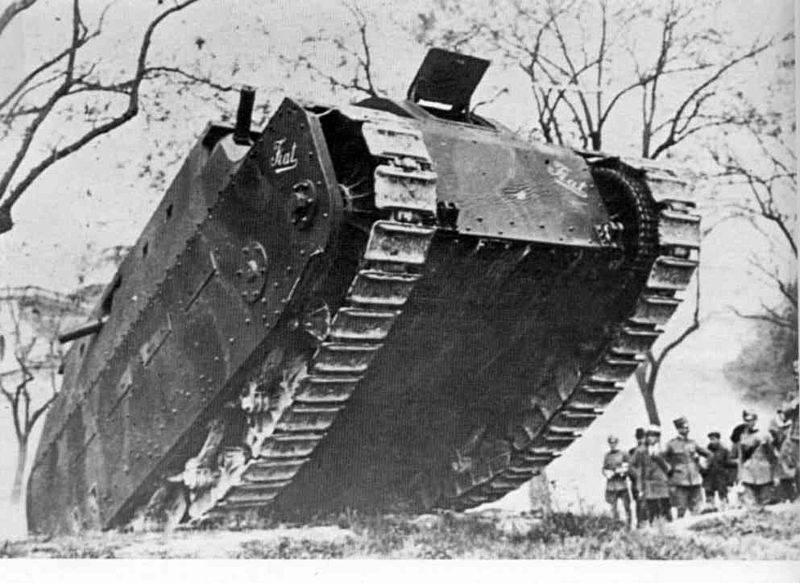
Overcoming obstacles. Photo Daywarphoto.blogspot.ru
During the tests, insufficient engine performance was confirmed. 240-strong motor could not provide high speed on rough terrain. The maximum speed of the car did not exceed 7 km / h. However, it was enough to accompany the infantry in the offensive. The aircraft engine was also not economical: using the fuel supply in the 600 l, the tank could only go 75 km. At the same time, the tank had a good cross. It could climb the slope of the 40 ° steepness, cross a ditch up to 3,5 m wide, and also climb a wall of 0,9 m height. Water barriers up to 1 m depth were overcome ford.
At the beginning of 1918, almost simultaneously with the release of the first prototype of a new tank, the Italian command decided to order the construction of a series of 50-like machines. By the end of the year, a second copy of the Fiat 2000 tank was built, refined based on test results. In particular, it was he who became the first carrier of a new hemispherical tower. 1 April 1919, this car was first shown to the public. Soon two more or three tanks appeared. According to various sources, no more than 4-5 tanks were built: one prototype and three or four serial machines. In connection with the end of the First World War, the leadership of Italy considered it inappropriate to build a new technique in a large series. Further assembly of the Fiat 2000 type tanks was canceled.
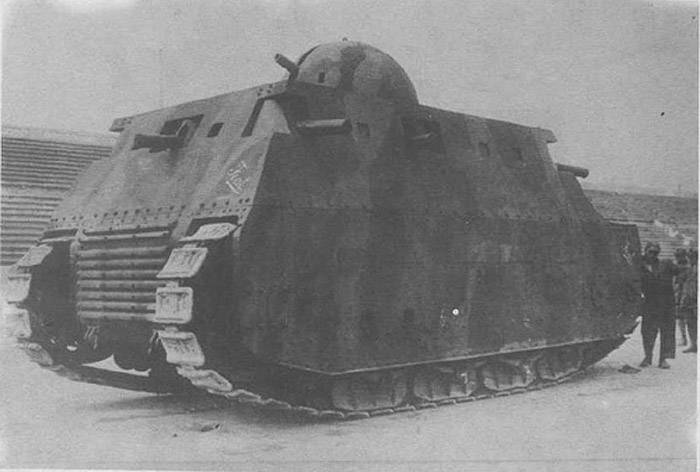
Serial Fiat 2000, view of the stern. Photo Aviarmor.net
In 1919, a unit was formed within the Italian army, which was to operate all the tanks of the new model. The Reparto Speciale di marcia carri d'Assalto division officially subordinated to the General Staff’s automobile administration, but the actual control was carried out by the command of artillery troops. The heavy tanks became part of two platoons, each of which was additionally given one French-made FT-17 light tank.
Operation in the army allowed to reveal previously unnoticed design flaws. The military again complained of unacceptably high fuel consumption and excessive shaking when moving. In addition, there was a serious risk of overheating of the engine, making it difficult for long-term movement of equipment. Also, regardless of the mode of operation of the power plant, the air temperature in the habitable compartment was high, and the only fan could not cope with the load. The high height of the tank and the high location of the center of gravity led to risks of a coup on some slopes. Nevertheless, despite all the shortcomings, the Fiat 2000 heavy tanks were generally considered fit for use by the troops.
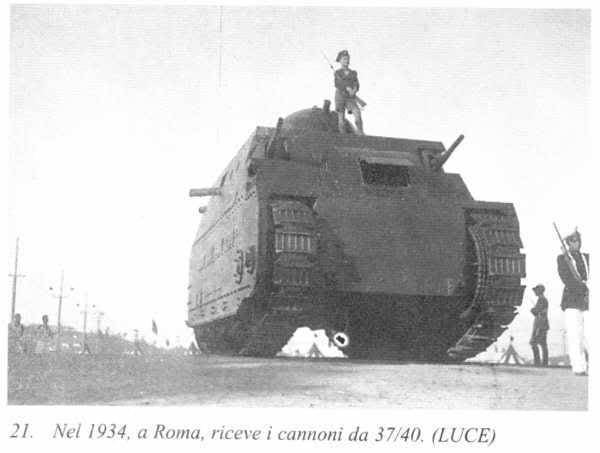
The tank that received the 37-mm gun. Photo Daywarphoto.blogspot.ru
At the beginning of 1919, one of the tanks of the new model was sent to Libya, where the crew had to fight the rebel Arab tribes. According to some data, next year the tank grouping in North Africa was reinforced by the remaining available tanks. According to other sources, the only tank was left in Libya, withdrawing into a separate artillery platoon. The operation of the remaining machines, respectively, continued exclusively in Italy.
During the first half of the twenties, all available Fiat 2000 tanks were in intensive use. Later, as construction and supply of new tanks with higher performance, heavy armored vehicles began to be seen as an additional means of strengthening the troops. By the beginning of the thirties, all these tanks had become training machines and were located at various ranges, providing training for new crews for the front-line equipment. Return to the system as a full-fledged combat vehicles have not been planned.
However, in 1932, an attempt was made to upgrade the tanks with the use of new weapons. It was proposed to replace the front machine guns with two 37-mm guns. One of the tanks received such a weapon, but it didn’t get any further. The increase in firepower was an undoubted advantage, but the armored vehicles had already managed to work out their own resources, which is why their modernization was considered inexpedient. The rest of the tanks remained with the 65-mm cannon and seven machine guns.
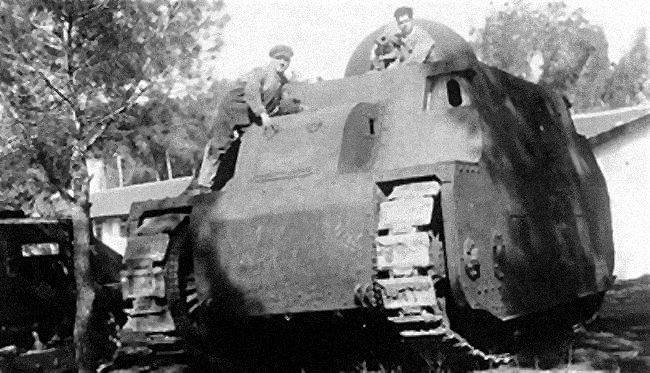
One of the tanks at the end of his career. Photo Daywarphoto.blogspot.ru
In 1934, an order was issued to remove Fiat 2000 tanks from service. Two cars that remained in Italy were sent for recycling. It is noteworthy that they got to the cutting point on their own, although not without technical problems. The "Libyan" tank was dismantled at the place of service: in order to save it, it was decided not to take it to Europe. Another tank, which had previously become the carrier of 37-mm guns, was sent to the 3-th tank regiment stationed in the city of Bologna, where it became a monument. The car lost parts of the units, received mock weapons and stood on a pedestal. According to reports, to this day this monument has not been preserved. A unique specimen was destroyed during World War II.
The heavy tank Fiat 2000 was the first car of its class, created and built in Italy. Lack of experience in the development and operation of such equipment led to natural results. The machine did not differ in high performance, which is why it was hopelessly outdated only a few years after being put into service. Further attempts to upgrade and improve the tank did not give tangible results. However, without showing significant practical results, the Fiat 2000 project still occupied an important place in stories European tank building, and also contributed to the further development of armored vehicles in Italy.
On the materials of the sites:
http://aviarmor.net/
http://armor.kiev.ua/
http://tanks-encyclopedia.com/
http://militaryfactory.com/
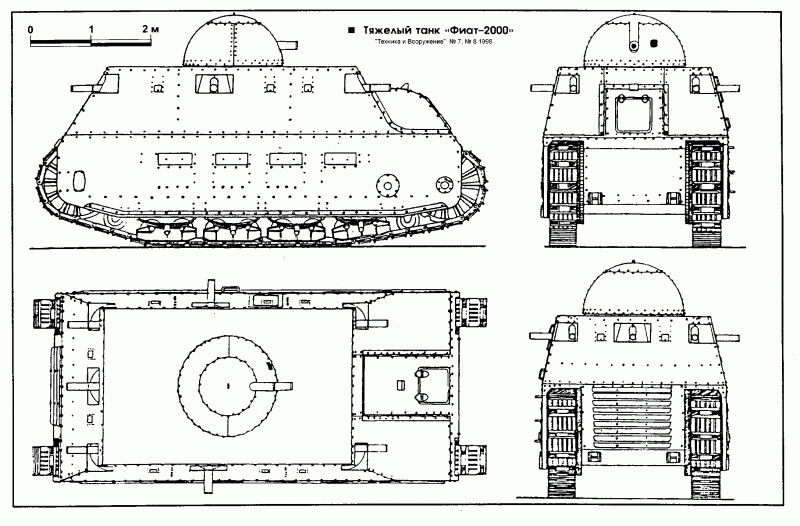
Information